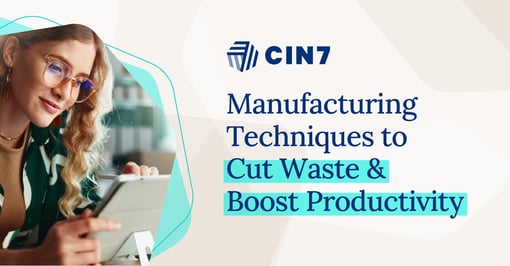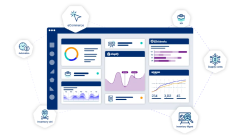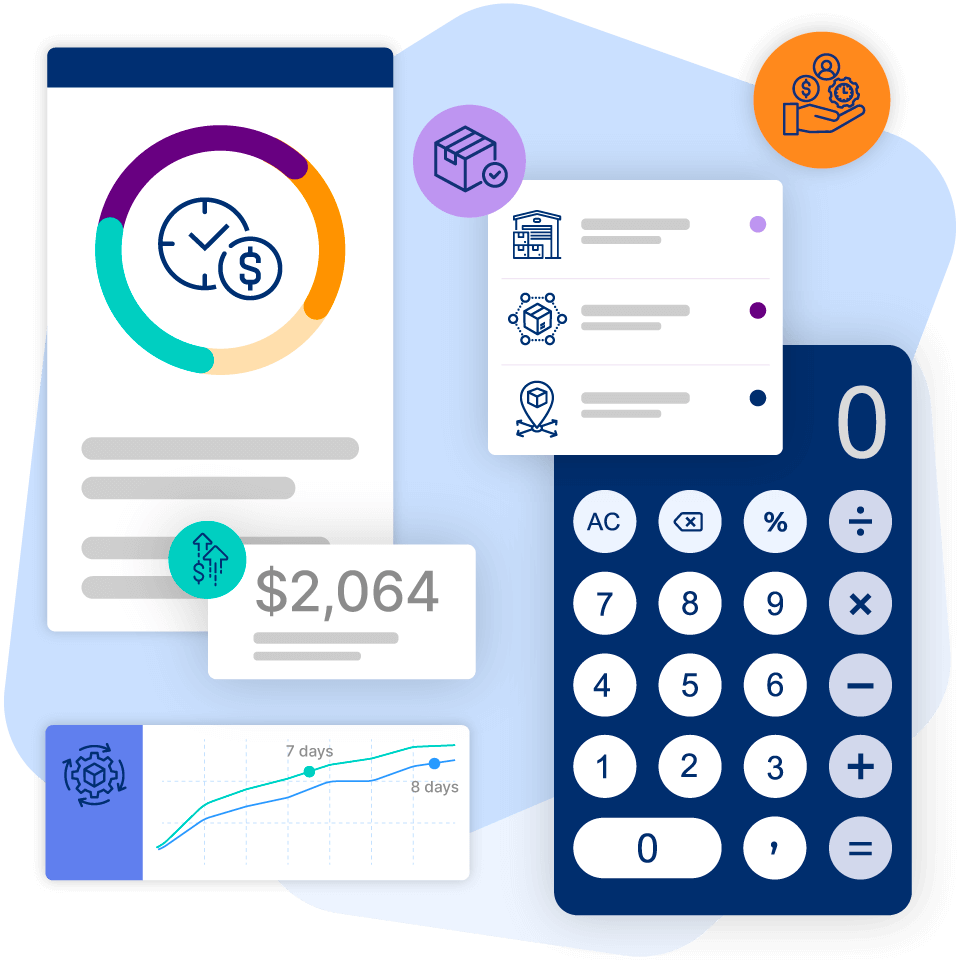Lean Production Techniques for Smarter, More Scalable Operations

Lean production is an operational methodology that focuses on minimizing waste within production systems while delivering the highest possible value to customers.
Waste in this context refers to any activity, process, or resource that consumes time, materials, or effort but doesn’t add value to the end product or service from the customer’s perspective. This waste can show up in several ways, including excess inventory, unnecessary movement of products, complex workflows, long wait times between different production stages, product defects that require rework, and many more.
The goal of lean is to tighten up every part of the production process so resources are used efficiently, and anything that doesn’t support quality, speed, or customer satisfaction is eliminated.
In this post, you’ll learn about the core principles, techniques, and key benefits of lean production, plus the technology you need to successfully implement lean methods in your organization.
A Brief History of Lean Production Techniques
The concept of lean comes from the Toyota Production System, which was developed in post-Second World War Japan. Faced with limited resources, Toyota engineers created a production system that emphasized efficiency, quality control, and constant improvement. This approach allowed them to build cars faster, with fewer defects, and at lower cost than traditional mass production methods.
Over time, the core ideas of the Toyota Production System were refined into what’s now known globally as lean manufacturing or lean production. These principles have since been adopted beyond automotive manufacturing and are now applied across a wide range of industries where manufacturing visibility, waste reduction, and efficiency are critical..
Core Principles of Lean Manufacturing
Lean production is built on five main principles:
Identify Value from the Customer’s Perspective
The starting point for any lean initiative is understanding what the market, or your customers, truly considers valuable in your products or services. This “value” can take many forms, such as a unique design, reliable quality, strong durability, fast shipping, or a simple ordering process.
Crucially, value must be defined from the customer’s point of view, not from that of designers or producers. This distinction matters because internal perceptions of value might not align with what customers truly prioritize or are willing to pay for.
For example, a furniture manufacturer might assume that what customers value most is the unique design of their products. However, customer feedback, production monitoring, or market research may reveal that fast delivery and easy assembly are the top priorities that influence purchase decisions and satisfaction.
Recognizing and focusing on what customers genuinely value makes sure that resources and efforts are directed toward features and services that matter most to them, rather than what might seem valuable internally.
Map the Value Stream
After defining value, the next step is to map every action involved in delivering it. This includes creating a visual representation of how materials, information, and work flows between teams and systems.
The goal of value stream mapping is to highlight where value is created and expose inefficiencies or waste so they can be eliminated or improved. One common finding during this process is uncovering a bottleneck in production, which often slows throughput and drives up costs.
The eight classic types of waste identified in lean methodology and that value stream mapping specifically aims to eradicate are:
- Overproduction
- Waiting (idle time between processes)
- Unnecessary transportation
- Overprocessing (adding features with no customer benefit)
- Excess inventory
- Unnecessary movement of people
- Defects that must be reworked
As an example, a manufacturer producing consumer electronics might uncover that components are being transported multiple times between stations due to a poorly arranged floor layout. Or, a factory might find that it’s holding too much inventory of a slow-moving component, tying up capital and storage space.
Overall, value streaming helps businesses identify areas where waste accumulates and begin designing a production system that’s more efficient.
Create Continuous Flow
After waste has been identified and removed, the focus shifts to creating a smooth, uninterrupted flow of work across all stages of production and fulfillment. Continuous flow means that products, tasks, or information move from one step to the next without unnecessary delays, waiting periods, or backlogs.
Achieving this kind of flow often requires a series of adjustments. For example, equipment might need to be rearranged to minimize movement between workstations. Task sequences may be restructured so that each handoff happens efficiently and with minimal downtime. In some cases, batch processing must be replaced with smaller, more frequent cycles to prevent backlogs.
Creating a continuous flow reduces idle time, improves predictability, and allows teams to respond quickly to demand fluctuations.
Establish Pull-Based Production
Traditional production often involves "push" systems, where goods are produced based on forecasts and then pushed through the process regardless of real-time demand. This approach often leads to waste, such as overproduction and excess inventory.
Lean advocates for a "pull" system. Pull-based production means that work is triggered by actual demand signals or usage patterns rather than forecasts or production schedules. Instead of producing large batches ahead of time, for example, each step in the manufacturing process is initiated only when the next step is ready to receive it.
In a manufacturing environment, this might look like a workstation receiving a signal indicating that more components are needed downstream. Only then does production begin. This keeps inventory levels low and helps ensure that resources are only used when there’s a clear need.
Strive for Perfection Through Continuous Improvement
The journey toward lean production never truly ends. The fifth and final principle of lean emphasizes a constant pursuit of perfection through incremental, ongoing refinement. This principle, which is referred to as Kaizen (more on this later), involves regularly re-evaluating processes, finding new ways to eliminate waste, and encouraging everyone in the organization to continuously identify and solve problems.
Top Lean Production Techniques Used by Today’s Fast-Growing Businesses
To put lean concepts into action, businesses use a wide range of techniques, including the following:
5S (Sort, Set, Shine, Standardize, Sustain)
The 5S method focuses on organizing the workplace to reduce waste and improve productivity.
Sorting
It starts with sorting, which involves removing all unnecessary items from the work area. For instance, in a warehouse, this means clearing out old, broken equipment or excess packaging materials that are not actively in use.
Setting
Next is setting, which means arranging necessary items so they are easy to find and use. This typically involves clear labeling, color coding, or using designated storage, like shadow boards for tools.
Shine
Shine focuses on keeping the workspace thoroughly clean and tidy, which makes it easy to spot issues such as fluid leaks or equipment wear.
Standardize
The fourth S, Standardize, involves establishing consistent procedures, guidelines, and visual controls to ensure that the first three practices become routine.
Sustain
Finally, sustain aims to make 5S a habit and an integral part of the organizational culture through discipline and continuous adherence to these habits.
Just-in-Time (JIT) Inventory Management
Just-in-Time, or JIT, is an inventory and production strategy focused on receiving raw materials or producing sub-assemblies only when they are needed for the next stage in the manufacturing process, or specifically when a finished product is demanded by a customer.
The central aim of JIT is to minimize holding large quantities of inventory, which typically ties up significant capital, consumes valuable storage space, and carries risks like obsolescence, damage, or spoilage.
For a manufacturing company, JIT could mean arranging for a supplier to deliver components daily, or even hourly, directly to the assembly line as they are consumed, rather than stocking weeks' worth of material in a warehouse.
Kanban
Kanban is a visual method used to manage workflow within an organization. This visual method makes it easier to stay efficient and quickly identify problems in the production process.
The Kanban model involves representing the flow of work on a large board divided into different columns. Each column corresponds to a specific phase in the work process, such as “To Do,” “Doing,” and “Done.” Work items are represented by cards or tickets that move across the board as tasks progress through each stage.
This movement allows teams to track the status of work in real time and easily see where tasks may be delayed or stuck. Some Kanban boards also include horizontal rows called swim lanes, which organize work by team, task type, or project, making the system even more flexible.
Traditionally, Kanban boards were physical and posted on bulletin boards in work areas. Today, many organizations use digital Kanban tools that offer the same structure, but with additional features like notifications, analytics, and remote access.
Regardless of format, the goal remains the same, and that is to visualize work clearly, promote steady flow, and support quick problem-solving.
Root Cause Problem Solving (RCPS)
Root Cause Problem Solving is a lean technique that focuses on identifying and eliminating the true cause of a problem, rather than the surface cause or the symptoms.
RCPS is based on the understanding that simply fixing the immediate issue, like restarting a machine or reworking a defective product, is not enough. These are temporary solutions that often lead to repeated failures.
RCPS encourages teams to dig deeper and ask, “Why did this happen?” until the real, underlying issue is uncovered. Once the root cause is known, meaningful and lasting improvements can be made.
Two of the most widely used tools in this process are the 5 Whys and the Fishbone Diagram (also known as the Ishikawa Diagram).
The 5 Whys entails repeatedly asking "why?" to peel back layers of symptoms and get to the fundamental issue.
For example, if a batch of manufactured parts consistently fails quality inspection, you might ask: "Why are the parts failing inspection?" (They are out of tolerance). "Why are they out of tolerance?" (The machine setting drifted). "Why did the machine setting drift?" (The operator forgot to calibrate it.) "Why did the operator forget?" (The calibration procedure isn't clearly documented.) "Why isn't it documented?" (No standard operating procedure exists in the organization.) Continuing this line of questioning helps uncover the underlying failure, which can then be fixed, solving the issue once and for all.
The Fishbone Diagrams, also known as Ishikawa Diagrams, meanwhile, organize potential causes into categories and systematically explore all possibilities.
The diagram gets its name from its shape. It resembles the skeleton of a fish, with the “head” representing the problem and the “bones” branching out to show different categories of causes. These might include people, machines, methods, materials, measurements, and environment.
Each category is then broken down into more specific potential causes. For example, under “methods,” you might list unclear procedures or inconsistent work instructions. This structured format helps teams explore all possible factors without jumping to conclusions.
Kaizen (Continuous, Incremental Improvement)
Kaizen is a philosophy that means “change for the better” and refers to continuous, incremental improvement involving everyone in an organization.
It’s based on the idea that a series of small, consistent changes and refinements will accumulate into significant improvements over time. Kaizen encourages all team members, regardless of their role, to identify problems, suggest solutions, and implement minor enhancements in their daily work.
The essence of Kaizen is cultivating a culture where improvement is everyone's responsibility and an ongoing commitment.
How Lean Techniques Improve Production, Profitability, and Team Agility
Lower Inventory Holding Costs and Improved Cash Flow
One of the most direct financial benefits of lean is reducing excess inventory. Using methods like Just-in-Time (JIT) and pull-based systems, manufacturers are able to align stock levels closely with actual demand, which reduces the amount of raw materials, work-in-progress, and finished goods they hold. That lowers storage costs, frees up cash for other uses and minimizes the risk of losses due to obsolescence or spoilage.
According to research, firms that implement lean principles lower their operational costs by between 20–30% in the first year alone.
More from the blog
View All Posts
How to Improve Manufacturing Process: 7 Proven Strategies
Read More
Eliminating Bottlenecks in Production to Reduce Downtime and Boost Productivity
Read More




